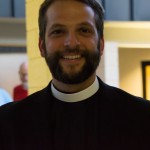Lectionary Reflection: Proper 11, Year B
2 Samuel 7:1-14a; Psalm 89:20-37; Ephesians 2:11-22; Mark 6:30-34; 53-56
 King David desired, and rightly so, to build for the Lord a permanent and suitable house – a temple. Now, a temple is a dwelling place for deity. A temple is a place where heaven and earth interlock, that is, a place where God’s space and man’s space converge.
King David desired, and rightly so, to build for the Lord a permanent and suitable house – a temple. Now, a temple is a dwelling place for deity. A temple is a place where heaven and earth interlock, that is, a place where God’s space and man’s space converge.
And to temple, to tabernacle, to dwell in our midst is God’s ancient and eternal goal. As the prophet Habakkuk says, “the earth shall be filled with the knowledge of the glory of the LORD, as the waters cover the sea” (Habakkuk 2:14, KJV). This is the telos of the cosmos.
We see this at the very beginning of history. Genesis 1-2 is the story of God making for Himself an abode. The creation narratives are replete with temple imagery. And at the end of history, we shall see God accomplish fully and finally that which he set out to do at the beginning. In Revelation 21, the Apostle John has this incredible vision of the marriage of heaven and earth wherein a loud voice cries, “Behold, the dwelling place of God is with man. He will dwell with them, and they will be His people and God Himself will be with them as their God” (Revelation 21:3, ESV).
Thus, Solomon’s temple and the Tabernacle before it were, quite literally, microcosms. They showed on a small scale God’s intention for the whole creation. They are Eschatological beacons. And that’s where God takes the conversation with David (via the prophet Nathan) in 2 Samuel 7, beyond types and shadows to the reality. He points beyond a son of David, Solomon, who would build the temple in the Jerusalem, to the Son of David, the Messiah. While David was speaking of building a house for God, God speaks of building a house for David (see 2 Samuel 7:11ff), a temple which turns out to be a person – Jesus Christ. “For in him dwelleth all the fulness of the Godhead bodily” (Colossians 2:9, KJV). It was Jesus, the Word, who “became flesh and dwelt [i.e. tabernacled] among us” (John 1:14, ESV). It is in Christ that heaven and earth overlap, yes, are united.
It is through Christ that the kingdom of God comes on earth as in heaven, that the world is put right; which is precisely what we see in Mark 6 with the healing of the sick: Christ renewing the world just as it will be renewed at the Last Day, that great and glorious day when there will be “death shall be no more, neither shall there be mourning, nor crying, nor pain anymore” (Revelation 21:4, ESV).
And the Church as the Mystical Body of Christ and dwelling place of the Holy Spirit is therefore also the temple of the new covenant. We are veritable members of that house which God promised to build for David and members of that household, that family, which has been formed in and through Christ. Paul beautifully brings together in Christ both the image of a house (i.e. a temple) and a household in this week’s epistle: “You are fellow citizens with the saints and members of the household of God, built on the foundation of the apostles and prophets, Christ Jesus himself being the cornerstone, in whom the whole structure, being joined together, grows into a holy temple in the Lord. In him you also are being built together into a dwelling place for God by the Spirit” (Ephesians 2:19b-22).
So, while it is a right and good thing to, like David, want to build things for God, we must remember that that only happens when we receive by grace that which God has built, and is building – “For we are his workmanship, created in Christ Jesus unto good works” (Ephesians 2:10, KJV). And when we surrender to the transforming work of the Holy Spirit, we will truly be a holy temple, a place where heaven and earth overlap, and the means by which God’s kingdom comes on earth as in heaven.
– Father Matthew Ainsley is assistant to the rector at Church of the Ascension in Orlando.
